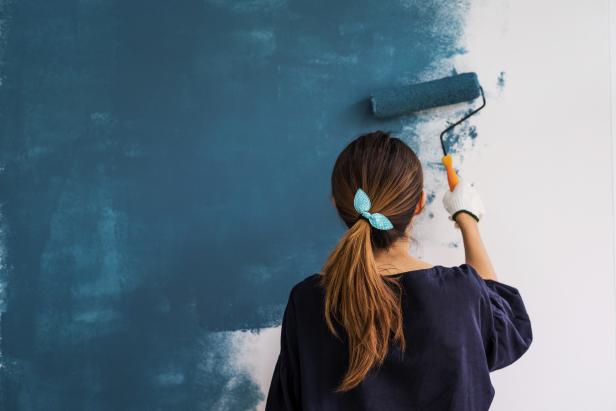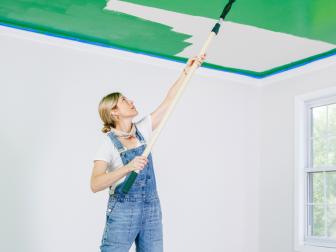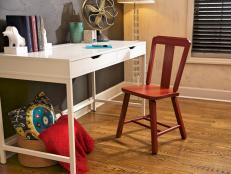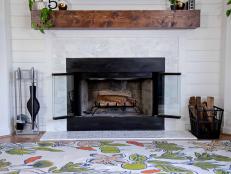Top 10 Ways to Paint Like a Pro
For a professional-looking paint job, do what the experts do.

Shutterstock/kitzcorner
These top tips will make your next paint job a smashing success, whether you're painting all your walls or just one.
1. Wait for Dry Weather
Humidity means drips and slow drying, so avoid painting on a rainy day. If you must paint when it's humid, take your time — and take advantage of slow-drying paint to correct your errors before moving on to the next coat. But don't overwork or it will show when you're finished.
Foolproof Paint Colors That Will Sell Your Home
Find out the best interior and exterior paint colors to sell your home.
2. Do a Thorough Visual Inspection and Prep
Any cracked, flaking or peeling areas need to be lightly sanded or scraped (and then thoroughly rinsed) before applying new primer and paint because the weight of the new coat will pull the old paint loose. "You'll just end up wasting your time and money if you don't tackle that first," says Tom Lee, Senior VP of Consumer Marketing for Behr. Greasy spots may also need a bit of washing with soap, followed by a rinse with clean water. Otherwise, wipe down with a damp cloth so that paint will have a clean, dust-free surface to stick to.
How to Repair Drywall
A well-placed piece of art may be the quickest way to disguise a hole in drywall, but for a professional fix, follow our tips for a smooth, finished surface.
3. Buy High-Quality Brushes, Roller Covers, and Painter's Tape
If you're splurging on great paint, you definitely don't want to pinch pennies on the application. Good brushes and roller covers give excellent coverage so that you don't waste time and paint on re-application, and high-end painter's tape is the real deal when it comes to sealing out drips and blurs.
4. Know Your Nap
The more texture your walls have, the thicker the nap you'll want on your roller cover so it can reach into crevices and give complete coverage. For example, you'll want to go with a thick nap if you're painting concrete walls. But for drywall, a thin nap is preferred. If you go with a nap that's too thick, you might actually create texture where you don't want it, so be prepared to give the salesperson details about what you're painting when you're buying your painting supplies.
All About Paint, Color and Tools
Learn what type of paint to use, which tools will work best and the basics for picking color schemes.
5. Protect Anything You Don't Want Painted
You will never regret the time you spend covering floors, furniture and hardware before you begin a paint project. Drop cloths are a must and small plastic sandwich bags secured with tape are an easy way to protect doorknobs.
Read This Before You Paint Your Front Door
Take note of these helpful hints before you pick up your brush.
6. Remove Light Switch and Outlet Covers
If you're impatient, you'll be tempted to skip this five-minute step, but don't.
7. Use Primer
Paint-and-primer combinations are fine if you already have a clean, smooth surface. But if there are any issues with the wall or it's been more than eight years since you last painted, bite the bullet and go with a separate primer. If you need to cover an especially challenging surface (say, glass or high-gloss paint), use a bonding primer such as Benjamin Moore's Insl-x Stix Waterborne Bonding Primer or KILZ Adhesion Interior & Exterior Bonding Primer.
8. Box Your Paint
Get the paint salesperson to help you with a realistic estimate of how much paint you'll really need so that you can buy it all at once. Then, instead of using one gallon at a time, combine all the paint into one large container and mix it thoroughly. This is known as "boxing" your paint, and it keeps your color consistent from beginning to end.
9. Let the Roller Do the Work
Today's premium paints flow on easily, and you've already chosen a good roller cover (right?), so there's no need to use much pressure. Be sure to use an extension pole so you can reach the maximum amount of area with the least effort — and without straining your back.
59 Inviting Colors to Paint a Front Door 59 Photos
Get some ideas from these colorful front doors.
10. Paint From Top to Bottom
After you've cut in your edges at the ceiling and baseboard using a brush, use your roller to apply paint from the ceiling downward. Amateurs often have telltale drips and spatters at the end of a paint job, but pros paint right over their mistakes as they work their way down the wall. Once an area starts to dry, it's best to leave it alone. Going back over it can leave marks and color streaks in the paint's surface.



















































